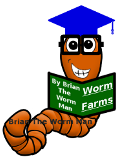Blue Worms – What You Need To Know – Perionyx excavatus
Identifying Blue Worms From Red Worms:
Some simple observation can help us in identifying these two species.
The clitellum (bulge or saddle) is the first thing to pay attention to.
In a RED WORM, this is 25 segments from the worm’s nose.
In a BLUE WORM, this is 13 segments from the worm’s nose.
The clitellum on a BLUE is also usually flush with the body.
On a Red, the clitellum is usually bulging outwards from the body.
Blues “just move funny” – like an inch worm kind of erratic, fast movement.
Reds are often more sedate, and may take longer to wake up to the fact that there’s someone staring at them, before they start to move.
Blues are often very skinny for how long they are.
Common Problems & Their Solutions
Lack Of Air – Increase Air Flow
Running short of food – Ensure well fed, by pocket feeding (link to FAQ guide)
Storms (Low Pressure Systems) – Nothing to be done but be aware
Some reason defying logic – Nothing to be done but be aware
In Australia, we have the Blue worms cousin – P.spenceralia.
The blues that I have seen personally, or heard about from fellow Aussies, do not exhibit the flighty behavior reported by my friends in the USA.
Perhaps this is why – or perhaps as most Aussies have the worms outside, we don’t notice a few worms “going rogue”.
Whereas in the USA it is quite common to have the worms inside, at least for winter – so maybe they notice it more/quicker?
Further Reading & Research If You “Have The Blues”:
For MORE GREAT INFO about Blue worms, my great friend and mentor, LJ Shier, wrote this fantastic e-book.
Check it out here:
Click The Button ^^ HERE ^^ To Get The Book
About This Book:
This book was written by my good friend and mentor, Larry J Shier.
Larry says:
“Blue Worms are misunderstood by many Worm farmers.
This guide is to help clear up some of the falsehoods out there and to make managing their troublesome ways easier.” – Larry J Shier (Facebook Group Admin, & Managing Partner, Worm Farming Alliance)

